"The Fascinating Lives of Emperor Penguins: Surviving in the Harshest Conditions on Earth"

The Fascinating Lives of Emperor Penguins: Surviving in the Harshest Conditions on Earth
As an animal researcher, I have always been fascinated by the lives of Emperor Penguins. These incredible creatures are renowned for their ability to survive in some of the harshest conditions on Earth, enduring temperatures as low as -60°C and winds of up to 200 km/h.
Emperor Penguins are the largest of all penguin species, standing at around 1.2 meters tall and weighing up to 45 kg. They are also the only penguin species that breeds during the harsh Antarctic winter, when temperatures are at their lowest. During this time, the penguins huddle together in large groups to conserve warmth and protect their eggs from the cold.
One of the most remarkable aspects of Emperor Penguin behavior is their incredible parenting skills. After laying their eggs, the female penguins transfer them to the males, who then incubate them on their feet for up to two months. During this time, the males must withstand the extreme cold and wind, while also going without food for weeks at a time.
Once the chicks hatch, the males continue to care for them, providing them with warmth and protection until they are old enough to fend for themselves. This process can take several months, during which time the penguins must survive on a diet of fish and krill, which they catch by diving to depths of up to 500 meters.
Despite the challenges they face, Emperor Penguins have adapted to their harsh environment in remarkable ways. Their thick layer of blubber provides insulation against the cold, while their streamlined bodies and powerful flippers allow them to swim through the icy waters with incredible speed and agility.
In conclusion, the lives of Emperor Penguins are truly fascinating, and studying these incredible creatures has provided us with valuable insights into how animals can adapt to even the harshest of environments. As researchers, we continue to be amazed by the resilience and tenacity of these remarkable birds, and we look forward to learning more about them in the years to come.
